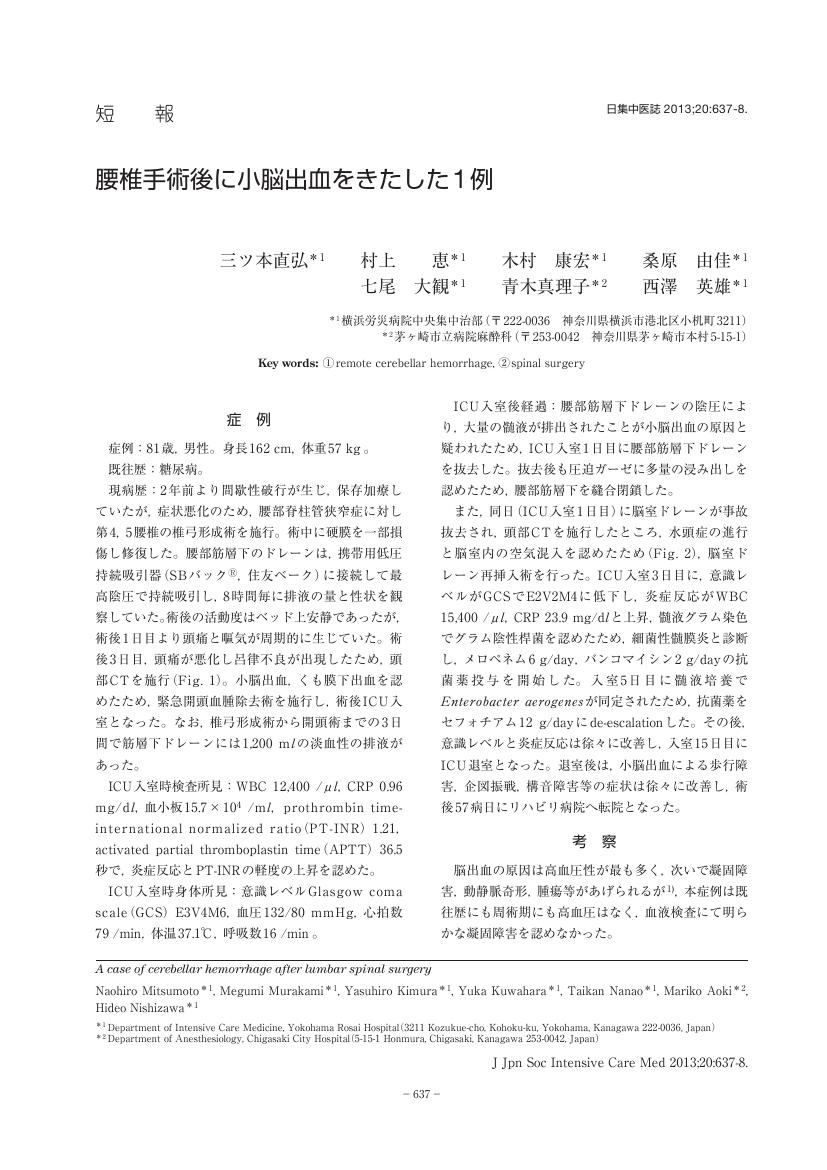3 0 0 0 OA 持続的腎代替療法により救命しえたメトホルミンによる乳酸アシドーシスの一例
- 著者
- 大和田 玄 岡野 弘 木村 康宏 吉田 輔 七尾 大観 藤本 潤一 西澤 英雄
- 出版者
- 一般社団法人 日本集中治療医学会
- 雑誌
- 日本集中治療医学会雑誌 (ISSN:13407988)
- 巻号頁・発行日
- vol.26, no.4, pp.273-274, 2019-07-01 (Released:2019-07-01)
- 参考文献数
- 6
2 0 0 0 OA イソフルランで長期管理したてんかん重積の一例
- 著者
- 赤川 玄樹 小野 富士恵 柏 健一郎 木村 康宏 七尾 大観 藤本 潤一 西澤 英雄
- 出版者
- 一般社団法人 日本集中治療医学会
- 雑誌
- 日本集中治療医学会雑誌 (ISSN:13407988)
- 巻号頁・発行日
- vol.23, no.3, pp.328-332, 2016-05-01 (Released:2016-05-02)
- 参考文献数
- 20
- 被引用文献数
- 1
症例は17歳,女性。意識障害を主訴に当院受診。てんかん重積状態(status epilepticus, SE)の診断で入院となり,第2病日に呼吸管理目的にてICU入室となった。SEの原因は入院中の精査で全身性エリテマトーデス(systemic lupus erythematosus, SLE)と判明した。原疾患の治療を行いつつ,SEのコントロール目的に抗痙攣薬を開始したがコントロールがつかず,静脈麻酔薬による全身麻酔療法を開始した。それでもSEのコントロールに難渋したため,第10病日より吸入麻酔薬のイソフルランを併用した。その使用期間は38日間に及んだが,経過中イソフルランの使用に伴う重篤な合併症はみられず,比較的長期間安全に管理することができた。静脈麻酔薬による全身麻酔療法でSEのコントロールに難渋する場合には,吸入麻酔薬を併用することも選択肢の一つと考えられた。
1 0 0 0 OA 低カリウム血症により高アンモニア血症を発症したと考えられた非肝不全症例
- 著者
- 金子 尚樹 西澤 英雄 藤本 潤一 七尾 大観 木村 康宏 大和田 玄 森村 太一
- 出版者
- 一般社団法人 日本集中治療医学会
- 雑誌
- 日本集中治療医学会雑誌 (ISSN:13407988)
- 巻号頁・発行日
- vol.29, no.4, pp.271-274, 2022-07-01 (Released:2022-07-01)
- 参考文献数
- 8
低カリウム血症では近位尿細管でのアンモニア産生が増加するため,肝性脳症患者では高アンモニア血症の増悪因子となり得る。ただし,肝不全や門脈体循環シャントがないにもかかわらず低カリウム血症により高アンモニア血症をきたした報告例は非常にまれである。本症例は77歳の脂肪肝患者で,常用薬であった芍薬甘草湯の偽性アルドステロン症による低カリウム血症と,意識障害を伴う高アンモニア血症を認めたが,血清カリウム値の上昇に伴い高アンモニア血症と意識障害も改善した。①低カリウム血症による近位尿細管でのアンモニア産生増加や,②アルカローシスによるアンモニアの血中への移行増加,③慢性低カリウム血症による尿素合成能低下や④脂肪肝による尿素合成能低下によって高アンモニア血症をきたしたと考えられた。したがって,肝機能障害の程度にかかわらず,低カリウム血症と意識障害を認めた際は高アンモニア血症を鑑別する必要がある。
1 0 0 0 OA 野球投手が投じる様々な球種の運動学的特徴
- 著者
- 永見 智行 木村 康宏 彼末 一之 矢内 利政
- 出版者
- 一般社団法人 日本体育・スポーツ・健康学会
- 雑誌
- 体育学研究 (ISSN:04846710)
- 巻号頁・発行日
- pp.16021, (Released:2016-08-29)
- 参考文献数
- 25
- 被引用文献数
- 4 5
In this study, we analyzed the kinematic characteristics of various types of baseball pitches by elite baseball pitchers, and tested a null hypothesis that “no type of pitch has the same kinematic characteristics as another.” A high-speed video camera was used to record the initial trajectory of the pitched ball thrown by 84 skilled baseball pitchers. Each pitcher was asked to throw all the different types of pitch he would use in competition and practice, and to self-declare the type of pitch used for each throw. The kinematic characteristics of each pitched ball were analyzed as ball speed, the direction of the spin axis, and the spin rate. A custom-made device was used to analyze the direction of the spin axis and the spin rate, and the ball speed was measured with a radar gun. One-way ANOVA with the Games-Howell post hoc test was used to test the hypothesis. The total of 364 pitches were categorized into 11 self-declared pitch types. Four of 10 pitch types thrown by more than one pitcher - the four-seam fastball, slider, curveball and cutter - had unique kinematic characteristic distinct from all of the other pitch types. No significant differences were found in any of the kinematic parameters between 1) changeup and sinker, 2) forkball and split-fingered fastball, and 3) two-seam fastball and shoot ball. Therefore, the hypothesis was retained for these three pairs of pitch types: although they were kinematically similar, the pitchers categorized them as different types. When the breaking ball was compared with the four-seam fastball, they were classifiable into three types: 1) pitches with a slower ball speed and lower spin rate with a different direction of spin axis (changeup, sinker, forkball and split-fingered fastball), 2) pitches with a slower ball speed, different direction of the spin axis and a spin rate comparable to the four-seam fastball (slider, curveball and cutter), and 3) pitches with a comparable ball speed, similar spin axis direction, and lower spin rate (two-seam fastball and shoot ball). These data revealed that the kinematic characteristics of some pitch types are quite different from those described in baseball coaching handbooks.
1 0 0 0 OA 腰椎手術後に小脳出血をきたした1例
- 著者
- 三ツ本 直弘 村上 恵 木村 康宏 桑原 由佳 七尾 大観 青木 真理子 西澤 英雄
- 出版者
- 一般社団法人 日本集中治療医学会
- 雑誌
- 日本集中治療医学会雑誌 (ISSN:13407988)
- 巻号頁・発行日
- vol.20, no.4, pp.637-638, 2013-10-01 (Released:2013-11-02)
- 参考文献数
- 8
